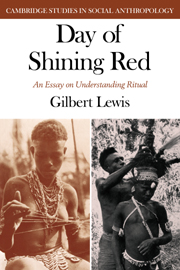Book contents
- Frontmatter
- Contents
- Analytical table of contents
- Preface
- 1 A question of interpretation
- 2 Problems of ritual in general
- 3 Views from one village
- 4 The rites of puberty seen
- 5 Rules of procedure and reflection on them
- 6 Silent forms but natural symbols?
- 7 Moon, river and other themes compared
- 8 For success in life
- 9 A choice of magic
- 10 Change and a rite falling into disuse
- 11 Inventory of themes
- References
- Index
- CAMBRIDGE STUDIES IN SOCIAL ANTHROPOLOGY
6 - Silent forms but natural symbols?
Published online by Cambridge University Press: 30 October 2009
- Frontmatter
- Contents
- Analytical table of contents
- Preface
- 1 A question of interpretation
- 2 Problems of ritual in general
- 3 Views from one village
- 4 The rites of puberty seen
- 5 Rules of procedure and reflection on them
- 6 Silent forms but natural symbols?
- 7 Moon, river and other themes compared
- 8 For success in life
- 9 A choice of magic
- 10 Change and a rite falling into disuse
- 11 Inventory of themes
- References
- Index
- CAMBRIDGE STUDIES IN SOCIAL ANTHROPOLOGY
Summary
I quoted some Gnau idioms, metaphors and symbolic actions in the last chapter: the moon and the evening star; the lyimaηgai banana planted in ashes; the bats in the hole and the sister's son sitting in the village (pp. 99–101). Gnau people do sometimes use metaphor and do sometimes understand the relationships involved in symbolic action and have the power to comment on them and explain them. The observation, which I stress, cuts this way: I have seen the act of penis-bleeding in the puberty rites. I may be tempted to interpret it as a symbolic menarche, but Gnau men said to me that they had not thought of it like that. By what right or argument shall I maintain that it is symbolic menarche even though they disagree? That it is a ‘natural symbol’, and they are silent about it? Is it symbolic in itself? Only to me? Or to them also, though somehow unadmitted, hidden from their conscious minds? This is the question with which I began.
If we think of drawing a parallel between the girl's menarche and the boy's penis-bleeding, we should consider first the grounds for comparing the girl's rites with the boy's and for seeing them as equivalent. Are the rites identical and bleeding the only thing that differentiates them? Do elements of the puberty rites recur in rites that mark the passing of later stages in the individual's life, and, if so, do these elements differentiate men from women, or identify them?
- Type
- Chapter
- Information
- Day of Shining Red , pp. 106 - 120Publisher: Cambridge University PressPrint publication year: 1980

